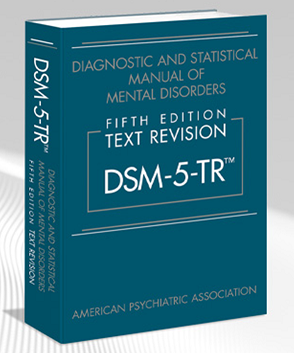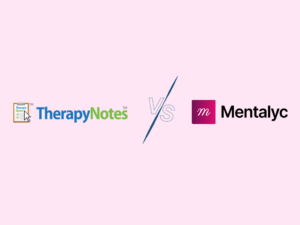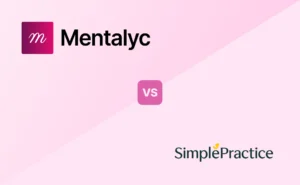Citing the DSM-5-TR in APA Format: Looking to cite the DSM-5-TR (Diagnostic and Statistical Manual of Mental Disorders, Fifth Edition, Text Revision) in your APA style references? Here’s a quick guide:
A new client comes into your office for the first time, nervous and uncertain about the process. After listening to their story, your mind starts categorizing and diagnosing, drawing on your years of experience and training with the Diagnostic and Statistical Manual of Mental Disorders (DSM). But wait – the DSM-5 got a text revision in 2022, and if you’re like many therapists, you haven’t had a chance to dive into the updates. Understandably, keeping up with the DSM’s frequent updates and complexity can be challenging for many clinicians.
In this post, we’ll decipher the Diagnostic and Statistical Manual of Mental Disorders, Fifth Edition, Text Revision (DSM-5 TR), highlight the fundamental changes you need to know, and share strategies for using this critical resource effectively in your practice. Whether you are a seasoned therapist looking to stay up-to-date or a student just beginning your training, after reading this comprehensive guide, you’ll feel confident to navigate diagnoses, incorporate the DSM-5 TR into your notes, and provide the best care for your clients. So, grab a cup of coffee, and let’s get started. The DSM-5 TR is waiting, and your clients are counting on you.
What Is the DSM-5 TR and Why Is It Important?
The DSM-5 TR is a guide published by the American Psychiatric Association (APA) to diagnose mental disorders and provide a common language for clinicians. It includes evidence-based diagnostic criteria, code revisions, dimensional assessments, and cultural considerations, which are crucial for billing and treating mental illnesses.

New! Transfer your notes to EHR with a single click. No more copy-pasting.
Using a manual as complex as the DSM-5 TR comes with challenges. However, you can harness its benefits to provide high-quality care by understanding and applying the manual judiciously. The DSM-5 TR, though imperfect, remains an indispensable tool for therapists and their clients.
To use the DSM-5 TR effectively:
Review the Manual Thoroughly
Familiarize yourself with new and revised diagnoses and changes to diagnostic criteria. Know which diagnoses require a differential to rule out other conditions.
Apply Diagnoses Carefully
Consider differential diagnoses and rule-outs. Avoid over-diagnosing or hastily diagnosing patients. Think about the pros and cons of assigning a diagnosis to a patient.
Stay Up to Date with Changes
The DSM is continuously revised. Follow the APA for updates to ensure you use the latest diagnostic standards.
Key Updates and Revisions in the DSM-5 TR
The DSM-5 TR improves diagnostic accuracy by providing specific criteria for disorders based on the latest advancements and clinical practices. Here are the critical updates and revisions for clinicians:
Diagnostic Changes
Some diagnoses have been reorganized, renamed, or removed. For example, “Gender Dysphoria” is now “Gender Incongruence.” “Hypoactive Sexual Desire Disorder” and “Female Sexual Interest/Arousal Disorder” were combined into one diagnosis of “Sexual Interest/Arousal Disorder.” And “Asperger’s Disorder” was incorporated into the broader diagnosis of “Autism Spectrum Disorder.”
Dimensional Assessments
The DSM-5 TR now includes dimensional assessments for symptom severity, and specifiers to capture the diversity of patient experiences better. For instance, the “Posttraumatic Stress Disorder” diagnosis includes four distinct symptom clusters. The “Bipolar and Related Disorders” section specifies anxiety, rapid cycling, and seasonal patterns.
Additionally, the criteria for major depressive disorder now include duration, severity, and frequency of symptoms. Further, the DSM-5 TR recognizes that PTSD can result from a broader range of traumatic events like natural disasters, accidents, or life-threatening illnesses. It also acknowledges that bipolar disorder can begin in adolescence and young adulthood, not just midlife, as previously thought.
Culture and Age Considerations
The latest edition provides expanded guidance around cultural differences that can affect diagnosis and the expression of symptoms. It also includes developmental age considerations for assessing criteria at different life stages. These additions will help reduce overdiagnosis or misdiagnosis due to cultural or age-related factors.
ICD-10-CM Codes
For the first time, the DSM-5 TR lists the corresponding ICD-10-CM insurance billing codes right next to each diagnosis. This helps ensure you are using the proper codes for reimbursement and makes the process more efficient.
While the DSM-5 TR brings many beneficial changes, adjusting to the new criteria and incorporating the updates into your practice will take time. But by understanding the critical revisions, you’ll be better equipped to harness the DSM-5 TR to support your clients thoughtfully and with cultural sensitivity.
Citing the DSM-5 TR in Your Therapy Notes
It is crucial to properly cite the DSM-5 TR when documenting a client’s treatment as a therapist. You will frequently reference this diagnostic tool in your notes, so here are some tips to ensure correct citation:
Use the Full Name Initially
The first time you mention the DSM-5 TR in your notes, use its complete name, “Diagnostic and Statistical Manual of Mental Disorders, 5th Edition, Text Revision.” After that, you can abbreviate it as “DSM-5 TR.” Be consistent with how you refer to it throughout your notes.
Cite Chapter and Code
When identifying a client’s diagnosis, note the full chapter name, code, and name, e.g., “Posttraumatic Stress Disorder, 309.81 (F43.10).” The chapter refers to the diagnostic category, the code refers to the specific diagnosis, and the name in parentheses is the ICD-10-CM code.
Quote Criteria
If you quote or paraphrase the diagnostic criteria for a disorder, cite the page number, e.g., “To meet criteria for PTSD, the individual must have been exposed to actual or threatened death, serious injury or sexual violence (DSM-5 TR, p. 271).” The page number allows anyone reading the notes to look up the source.
Avoid Common Pitfalls
Some challenges to watch out for:
- Don’t cite older versions of the DSM. Always use DSM-5 TR.
- Double-check that the diagnostic codes and criteria you’re citing are current. The DSM-5 TR is updated frequently.
- Don’t make up disorders or criteria that don’t exist in the DSM-5 TR. Only cite information that is actually in the manual.
- Don’t over-pathologize everyday client concerns or life struggles.
By following these recommendations, you can accurately incorporate DSM-5 TR into your notes and strengthen your clinical documentation.
Incorporating the DSM-5 TR Into Your Clinical Practice
To provide effective treatment, you must utilize DSM-5 TR daily in your practice. This can improve client care using the latest criteria and codes for accurate diagnosis. To fully benefit from the DSM-5 TR, it is important to familiarize yourself with the changes and updates from the previous version.
When conducting initial assessments, refer to the DSM-5 TR criteria to determine accurate diagnoses. Before assigning a diagnosis, check that your client’s symptoms match the criteria for specific disorders. Document how the symptoms meet the criteria in your notes. For example:
- The client reports feeling sad or hopeless nearly daily over the past two weeks. Meets Criterion A for Major Depressive Disorder.
- The client exhibits impaired social communication and restricted repetitive behavior patterns. Meets Criteria A and B for Autism Spectrum Disorder.
Regularly using the DSM-5 TR can provide a wealth of information and insights to enhance your practice and improve patient outcomes. However, it is important to note that critical thinking should always be relied upon when determining appropriate diagnoses and treatments for challenging cases. Additionally, it is vital to be aware of potential issues with over-diagnosis or under-diagnosis, as the DSM-5 TR is not a substitute for clinical expertise.
Avoiding Common Challenges When Using the DSM-5 TR
Some clinicians view the DSM-5 TR as an absolute authority, applying diagnoses too rigidly. However, it’s important to remember that the DSM-5 TR is meant as a guideline, not a concrete rulebook. Diagnoses are imperfect tools, and there is often disagreement among professionals. Use your clinical experience when determining if a diagnosis truly fits a client or if other factors better account for their symptoms.
Be cautious of “diagnosis creep,” or the tendency to apply more and more diagnoses to a single client. Too many co-occurring disorders can complicate treatment planning and lead to less effective interventions. Only use diagnoses when warranted, and be parsimonious.
Similarly, be wary of overly relying on medication as a first-line treatment. Medication should only be used when other interventions are not adequately helping a client or when symptoms are severe enough to warrant more immediate relief. Many disorders can be treated effectively with psychotherapy alone.
Avoid “checklist syndrome,” or going through the diagnostic criteria like a checklist without genuinely understanding the nuances of a disorder or how it impacts a particular client. Diagnoses are complex, and symptoms can manifest differently in each individual. Take time to gain a deep understanding of the disorders you commonly encounter.
The DSM-5 TR, while undeniably advantageous, must be utilized carefully and always prioritizing the client’s needs. Similarly, the DSM-5 TR should never replace a thoughtful, empathetic approach to treatment. Use your clinical judgment, understand the complexity of diagnoses, and focus on the whole person in front of you. With prudent use, the DSM-5 TR can enhance your practice rather than lead to challenges.
Understanding and Applying the New Diagnoses in the DSM-5 TR
The DSM-5 TR includes several new diagnoses and revisions to existing ones that you’ll want to understand to cite in your therapy notes properly and incorporate into your practice.
Autism Spectrum Disorder
The DSM-5 TR folds several previous diagnoses like Asperger’s syndrome into the broad diagnosis of Autism Spectrum Disorder (ASD). ASD is now diagnosed based on the severity of symptoms in social communication and restricted repetitive behaviors. This change aims to reflect better the diversity of symptoms and severity on the autism spectrum.
Hoarding Disorder
Hoarding disorder is now recognized as a distinct mental health condition. The diagnosis requires persistent difficulty discarding or parting with possessions due to a perceived need to save the items and the distress associated with discarding them. Hoarding must cause significant impairment in functioning to meet the criteria for the disorder.
Excoriation (Skin-Picking) Disorder
Excoriation disorder, also known as dermatillomania or skin-picking disorder, is characterized by recurrent skin picking that results in skin lesions and causes significant disruption in functioning. It is listed under “Obsessive-Compulsive and Related Disorders” and may be a valuable diagnosis for some clients.
Avoidant/Restrictive Food Intake Disorder
Previously known as “feeding disorder of infancy or early childhood,” this diagnosis now applies to patients of any age with an eating or feeding disturbance. It aims to characterize those with an avoidance or restriction of food intake that isn’t due to a lack of food or cultural practices.
Revisions to Existing Diagnoses: What Has Changed?
The DSM-5 TR includes several revisions to existing diagnoses that provide important updates for clinicians. Some changes clarify or expand diagnostic criteria, while others aim to reduce stigma or increase cultural sensitivity.
Autism Spectrum Disorder
The subtypes (Asperger’s Syndrome, Autistic Disorder, etc.) have been combined into one umbrella diagnosis of ASD. Additional specifiers also allow you to note severity, verbal ability, and the presence of an intellectual disability.
Substance Use Disorders
Substance abuse and dependence have been combined into a single Substance Use Disorder diagnosis with mild, moderate, and severe specifiers. This change moves away from the idea of substance “dependence” and more accurately reflects the compulsive nature of addiction. The diagnostic criteria have also been expanded to include craving and compulsion. These changes aim to reduce stigma and provide clinicians with more flexibility.
Bipolar Disorders
Bipolar II Disorder now includes hypomanic episodes lasting at least four days. This longer duration helps distinguish hypomania from normal mood variations and provides more consistency across cultures. The criteria for Bipolar I Disorder have also been clarified.
Depressive Disorders
The bereavement exclusion for Major Depressive Disorder (MDD) has been removed. This acknowledges that grief can trigger MDD and aims to reduce stigma by increasing awareness of mental health issues. Premenstrual Dysphoric Disorder has also been added as a separate diagnosis.
These are just a few changes and updates in the DSM-5 TR that provide essential guidance for diagnosis and treatment. As you incorporate the revised manual into your practice, note the specific changes for any diagnoses you commonly assess and treat. Paying close attention to these details will help ensure you provide the best care based on the latest criteria.
Using the DSM-5 TR to Drive Treatment Planning
Now that you have a diagnosis developing a tailored treatment plan is time. The DSM-5 TR should guide how you approach therapy for your client.
Focus on Symptoms
Pay close attention to the symptom criteria for your client’s diagnosis. Note which symptoms they meet and which they do not. Their treatment should primarily target the symptoms they are experiencing. For example, exposure therapy may be appropriate for phobias, while cognitive techniques are better for specific anxiety disorders.
Consider Severity
The DSM-5 TR uses a dimensional approach to diagnosis, recognizing that disorders exist on a continuum from mild to severe. A client with severe OCD will likely need a different treatment plan than someone with mild OCD. Severity can also change over time with treatment. Continually reassess your client’s symptoms to adjust the treatment plan accordingly.
Explore Related Conditions
Comorbid disorders are very common, so review the DSM-5 TR differential diagnosis and associated features of the primary disorder. Your client may meet the criteria for a related condition that needs treatment. For example, many people with substance use disorders also suffer from co-occurring mental health conditions.
Set Specific Goals
Work with your client to set concrete goals for treatment based on their symptoms and diagnosis. Refer to the DSM-5 TR prognosis for realistic expectations about potential outcomes. Goals include reducing symptoms by a certain percentage, avoiding harmful behaviors, improving relationships, or maintaining employment.
Review and Revise
Refer to the DSM-5 TR to reassess your client’s symptoms and diagnosis as treatment progresses. Their condition may change or evolve, requiring adjustments to goals and treatment. Staying up to date with the DSM-5 TR will ensure you use the latest evidence-based practices to support your clients. These tips for incorporating the DSM-5 TR into treatment planning will help provide your clients with the most effective, tailored care. But remember, each client is unique, so use the manual as a guide rather than strict rules.
DSM-5 TR FAQs: Answering Your Questions
As a therapist, you know the importance of staying up-to-date on the latest criteria and codes for mental health diagnoses. The DSM-5 TR is a crucial resource for effective treatment and billing, but its size and complexity can be overwhelming. Fortunately, there are answers to your most frequently asked questions that can help demystify this essential tool.
What’s new in the DSM-5 TR?
The DSM-5 TR includes several new diagnoses, including hoarding disorder, disruptive mood disregulation disorder, and gaming disorder. It also revises criteria for PTSD, autism spectrum disorder, and substance use disorders. The latest version incorporates cultural considerations, dimensional assessments for some disorders, and updates based on the latest research.
How do I cite the DSM-5 TR in therapy notes?
When documenting a diagnosis in your notes, cite the DSM-5 TR like this:
Diagnosis: Generalized Anxiety Disorder (GAD), F41.1 (DSM-5 TR)
You only need to include the code (e.g., F41.1) if required for billing. Referring to the DSM-5 TR by name and edition is sufficient.
What are the challenges of using the DSM-5 TR?
Some common issues include:
- Comorbidity: Many clients meet multiple diagnoses’ criteria, making determining primary and secondary disorders difficult.
- Diagnostic ambiguity: Some symptoms overlap across diagnoses, and clients don’t always fit neatly into categories.
- Cultural bias: The DSM-5 TR aims to be culturally sensitive but may not adequately represent all populations.
- Insurance issues: Not all insurance companies have adopted the DSM-5 TR, which can complicate billing.
- Information overload: The wealth of information in the DSM-5 TR can feel overwhelming. Focus on diagnoses and codes relevant to your clients.
As a practitioner, it’s crucial to have a solid understanding of the DSM-5 TR and keep up with its updates. While it’s not perfect, it’s a vital resource that aims to represent the current understanding of mental illness and provide a common language for clinicians. By being aware of its limitations and best practices, you can use it to provide the best possible care for your clients.
Remember that therapy is an art, and the DSM-5 TR is just a manual. It is essential to use your judgment and see your clients as unique individuals with their own experiences. While the DSM-5 TR can be helpful when used correctly, it can’t capture the complexity of human experiences entirely. Keep practicing, learning, and asking questions to improve your skills as a practitioner.
To stay current with the latest changes, subscribe to Mentalyc, a community of mental health practitioners dedicated to improving their craft, providing the best care to clients, maintaining clear communication, and the benefits of transparency in clinical reasoning.
Why other mental health professionals love Mentalyc

“It’s so quick and easy to do notes now … I used to stay late two hours to finish my notes. Now it’s a breeze.”
Licensed Professional Counselor

“It takes me less than 5 minutes to complete notes … it’s a huge time saver, a huge stress reliever.”
Licensed Marriage and Family Therapist

“By the end of the day, usually by the end of the session, I have my documentation done. I have a thorough, comprehensive note … It’s just saving me hours every week.”
CDCII

“Having Mentalyc take away some of the work from me has allowed me to be more present when I’m in session with clients … it took a lot of pressure off.”
LPC






